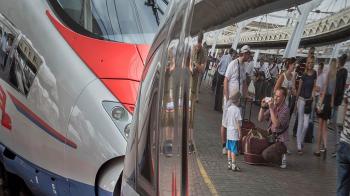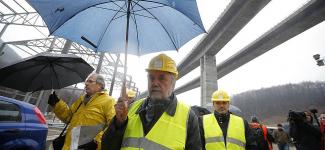Home › Projects › White Book › The Geopolitics of Transportation
The Geopolitics of Transportation

In our epoch of interpenetration and interdependence of national economies, cross-regional and cross-continental trade in different types of resources and diverse commodities, international transportation and transit are especially important and become a basis for functioning of the global economy. Economic globalization and globalization in general is a multidimensional and intrinsically contradictory phenomenon with a plethora of direct and inverse relations, involving multinational, national and supranational commercial entities, nation states and their institutions, regional intergovernmental associations, formal and informal international organizations, relationships among which are characterized by a combination of tough competition and elements of interaction and cooperation.
However, please keep in mind that the fundamental risk inherent in globalization is a political project aimed at weakening nation state for the benefit of a single pole of economic and political might. At the same time, it is safe to say that recently the policies of many countries (mainly BRICS, Greece, Serbia, Venezuela, etc.) have shown clearer evidence of striving for alternative globalization model and abandoning the utopia of destruction and desovereignization of nation states. A parallel trend has been intense worldwide: nations are beginning to form unions and large integration projects based on economic and cultural ties. The formation of regional integration association is aligned with a global trend of globalization replacement with regionalization.
Countries capable of establishing geostrategic alliances with their neighbors and benefitting from their geographic location and transit capabilities enjoy direct investment in infrastructure development and the implementation of state-of-the-art transportation equipment and technologies due to transit arrangements. Through regional associations and transit capabilities the national transportation system gets integrated into global transport and logistics corridors, thus giving strong impetus to economic development of regions and territories, securing beneficial conditions for domestic traffic growth and fostering the growth of national foreign trade, as well as contributing, in many respects, to social problem-solving, such as creation of new jobs, vital, socio-economic and cultural infrastructure. International transport corridors (ITCs) have been, and are still being, created both transnationally and transcontinentally with a view to optimizing, accelerating, cost-cutting and ensuring proper service and safety of cargo delivery. The employment of geoeconomic and geofinancial technologies by countries, international unions and associations ensures access to global income and allows dominating in geoeconomic space. Integration processes, which are underway in national economies, the creation of interstate geoeconomic and geopolitical associations pose new challenges to the transportation industry, which can hardly be solved within a single country. Interstate cooperation requires joint efforts aimed at lowering administrative and infrastructural barriers, making not only infrastructure assets but also transport and logistics business more mutually affordable. For example, Jan Harder, Vice President for Business Development at Alstom Transport (who is in charge of Moscow – Kazan high-speed mainline project), believes that differences among political, operational, regulatory, industrial and technical requirements of conventional railway networks of METR countries are a barrier to the development of transportation in the region and, hence, the development of international transport corridors. In practice, the functioning and development of international transport corridors are possible due to the implementation of common policy aimed at eliminating administrative, technological, technical and economic barriers within a single corridor. Prerequisites include the implementation by all ITC member states of a coordinated policy aimed at harmonization, standardization and system-scale planning of economic aspects. Harmonization is required in aspects such as track gauge, traffic control system and special signaling systems, various power supply standards, specific transport safety rules, rolling stock operation and maintenance technologies. Unification efforts are necessary to improve transportation, specifically to ensure uninterruptible operation when crossing national borders. In addition to the unification of technical tools and standards in the field of traffic arrangements, common legal provisions must be developed within the framework of ITC. Uninterrupted traffic necessitates implementing regulatory mechanisms which do not infringe process participants and clearly regulate the work of non-resident carriers in cross-border areas, ultimately reflecting the interests of ITC member states. Harmonious partnership among all transport corridor participants – both states and transportation market players involved in the carriage process: carriers, logistics operators, infrastructure and rolling stock owners – shall be an essential condition for effective carriage arrangements within the framework of ITC. Differences in standards and track gauge are still the largest barrier to cooperation in the railway industry. However, experience shows that all problems are solvable.
Within the framework of international unions and associations and nationwide, work is underway to ensure harmonization of standards, development of common legal, engineering and technical solutions. Russian Railways are always ready for cooperation and partnership, joint projects, the formation of transit transport corridors. Good evidence is active involvement of RZD in International Union of Railways (UIC), where Doctor of Economics B. M. Lapidus heads the Moscow – Minsk – Berlin high-speed passenger service project implementation using the Spanish Talgo train with employment of automatic track gauge change, which, in principle, solves the problem of railway standards difference.
The advantages of Russian railroads consist not only in their transit potential but also in the capability of regular service all year round, in the ability to carry most of bulk cargo flows. The growth of rail traffic in the direction of Far Eastern ports and border checkpoints and in the opposite direction puts forward new objectives to rehabilitate the existing railway infrastructure in the Siberian and Far Eastern Federal Districts. In these regions, Russia has to accomplish an important and pressing objective, namely: to develop regional strategic cooperation with its neighbors – China, both Koreas and Mongolia, especially in the light of design and implementation of new global infrastructure projects.
China is developing and implementing a new large-scale strategy “One Belt, One Road,” combining the largest geopolitical infrastructural projects: the “Silk Road Economic Belt” and the “20th Century Maritime Silk Road.” The Silk Road Economic Belt will run from the coast of China through Central Asia to the Middle East and Russia and further to Europe. China has already established the Silkroad Foundation with a capital of $40 billion.
The 20th Century Maritime Silk Road is a network of routes linking Chinese ports to the ports of Singapore, Malaysia, Indonesia, Australia. China has gained extensive experience in building infrastructure and accumulated considerable financial resources it can invest in developing countries along the Maritime Silk Road line, which, in its turn, will strongly stimulate its economic potential. China has already founded the Asian Infrastructure Investment Bank with its headquarters in Beijing. Most of Asian countries and some European states expressed their will to join.
According to the Chinese, “One Belt, One Road” concept is aimed at global rebalancing. This is a strategy of China based on the principles of openness and inclusion since the People’s Republic of China is interested too much in developing regional economic cooperation with its neighbors. “One Belt, One Road” is not an alternative to infrastructure projects and plans of the Eurasian Union, to the plans and activities of the Shanghai Cooperation Organization (SCO) as simultaneous participation of the same countries in several regional economic projects is a common practice nowadays.
Conventional model of regional cooperation primarily considers the creation of mutually beneficial commercial and investment agreements and establishment of common customs policy, followed by the creation of interstate institutes (examples include the Customs Union, the Eurasian Economic Union).
The “One Belt, One Road” project is different from this model. Its principal goal is cooperation in the fields of commerce, transport and investment. According to the Chinese, it is possible to create the Eurasian economic zone, including China, Central Asia and Europe, within the Silk Road Economic Belt.
In February 2014, the heads of Russia and the People’s Republic of China reached an agreement on cooperation in the “One Belt, One Road” project implementation and its integration with the Russian Eurasian railways.
Nevertheless, Prime Minister of the People’s Republic of China emphasized that the “New Silk Road” project is not an alternative to the Russian project “Trans-Eurasian Belt RAZVITIE” (TEPR). The project concept was first presented on March 11, 2014, at the Presidium of the RussianAcademy of Sciences by three authors (Academy Member Mr. Osipov, Academy Member Mr. Sadovnichy, Doctor of Political Sciences Mr. Yakunin) and was unanimously supported by the Presidium.
In March 2015, the project, already as one of the four largest ones, was submitted on behalf of the Russian Academy of Sciences by Academy Member Mr. Fortov to the President of Russia Mr. Putin.
The global project “Trans-Eurasian Belt RAZVITIE” entails siting crucial elements of the new technical, industrial and socio-cultural system in Siberia and the Far East. Integral infrastructure system, combining transport, energy, telecommunications, drinking water, oil and gas transportation, will constitute its core and ensure the creation of new industries and new scientific and technological engineering towns along BAM (the Baikal-Amur Mainline) and the Trans-Siberian Railway.
The TEPR concept will ensure forming of regional economies, creating a single social “chessboard” of all nations living in the Russian Federation, and foster development. The “One Belt, One Road” project, in many respects, coincides with Russia’s concept of Trans-Eurasian Belt RAZVITIE, in this case relations of compatibility and complementarity rather than competition are evident. However, its most distinctive feature is focus on the formation of alternative model for global joint and integral development of economies and social sector of all stakeholders.
In the Central Asia, Russia and the Eurasian Economic Union were offered a unique opportunity to develop strategic partnership with Iran and Turkmenistan and to strengthen their positions in the Eurasian market of transit services due to recent commissioning (in early December 2014) of Kazakhstan – Turkmenistan – Iran interregional railway.
Current geoeconomic infrastructure and transport projects, to any extent, inevitably lead to further integration of economic activities. Improvements include intensified commodity exchange among countries, growth of international trade volumes, more complex financial activities, formation of a single global financial market, fluctuations in which are experienced by every single country, as evidenced by global-scale financial and economic crises. At the same time, international experience shows that investment in infrastructure, development of rail transport is a serious crisis management tool; subsequently, these measures will produce multiplier effect on many industries of national economy. A possible key instrument of economic stabilization in the context of overcoming financial and economic crises implications is transport infrastructure development, the implementation of geopolitically important megaprojects, such as the construction of high-speed lines.
In the modern word, development of ultra-high-speed rail service and the construction of ultra-high-speed lines measures a nation’s success and directly affects its prestige and external political image. Success and technological development of any country are mainly judged by the extent of high-tech solutions implementation in the economy. It is safe to say that ultra-high-speed lines belong to high-tech solutions.
Some international examples of ultra-high-speed line construction show that just one very-high-speed line, crossing just one region of a country, is able to change drastically the territory’s socio-economic status, to broaden its touristic potential and to attract considerable investment in adjacent industries. Illustrative historic examples include Japan, where most scientific centers (for example, on Honshu island) have been built near the Shinkansen very-high-speed line.
Very-high-speed traffic arrangements offer a unique chance to developed and developing nations. If utilized to a proper extent, it will allow a country to walk up several scientific and technical flights of stairs, give a strong impetus to development of the economy in general and each UHSM-related industry in particular. Moreover, for longer than one decade development of a network of very-high-speed lines in Europe has proven to be convenient to passengers, contributed to maintaining common political and economic space, allowing Europeans to travel between countries relatively quickly.
As far as the financial aspect of the issue is concerned, in Europe, for instance in Spain, 1 km of the Madrid – Segovia line cost €21 million; the line between Turin and Milan, Italy, cost €43.2 million per one km; in Germany, €63 million were spent on 1 km of the Stuttgart – Ulm line. In Japan, each kilometer of the line from Hachinohe to Sin-Aomori costs €47.7 million. The benchmark of the most cost-effective VHSL construction is China, where 1 km of the Harbin – Dalian section construction costs €13.1 million. For a few years already, VHSL implementation in the Russian Federation has been discussed, various options have been considered; before 2013, VHSL-1 (Moscow – Saint Petersburg line) construction was the most likely option. However, in May 2013, VHSL construction plans were adjusted and VHSM-2 (Moscow – Kazan) option was selected for elaboration and construction. Currently, Moscow – Kazan project very-high-speed line is undergoing high-level front-end engineering design.
VHSL-2 is one of initial phases of construction of integrated Eurasian high-speed transport corridor between Moscow and Beijing, the Silk Road Economic Belt to connect Europe and the Asia-Pacific Region. It will increase population mobility in the Russian regions and give impetus to the creation of large agglomerations along the entire mainline. Furthermore, travel time from Moscow to Beijing will be reduced from 130 hours to 30 hours. It will only take a few hours to get from the capital of Russia to Nizhni Novgorod and Kazan. Mainline construction will contribute to implementing innovative technologies in construction, mechanical engineering, further IT development. High-tech serve as the basis for VHSL as the contemplated train speed range is 200 – 400 km/h.
The principal technical parameters of VHSL-2 have already been determined at the front-end engineering design stage and recommended for further elaboration, preparation of the necessary documents and commencement of the mainline design phase. Further project development is impeded by inadequacy of the Russian legal framework and pending financial issues. Unless these are promptly solved, the very fact of project implementationя when planned may be placed at risk.
However, Chinese partners express willingness to join the project at any time, specifically in financial terms. China is eager to invest in the construction of Russia’s first very-high-speed line Moscow – Kazan RUB 302 billion, including RUB 52 billion contribution to authorized capital of the company to handle project implementation and RUB 250 billion loans to be provided by Chinese banks for a period of 20 years.
Transcontinental VHSL will be designed for passenger and freight high-speed service alike; supposedly, goods to be transported will include postal cargos, commodities in e-commerce, high-tech equipment, as well as components and spare parts for cars and many other goods.
According to scientists and experts, the Russian economy does need VHSL-2 construction project. It will have a strong social effect since the construction of very-high-speed lines is primarily a large-scale socio-economic objective pursued by the government for the benefit of its population. VHSL Construction is able to generate multiplier effect in the future in the principal branches of the Russian economy, such as iron-and-steel industry, mechanical engineering, electrical engineering, construction, energy and other industries.
Historically, the creation of very-high-speed line network produced the most impressive economic effects in Japan, a global pioneer of very-high-speed transport. Although in the first two years of operation ver-high-speed line generated JPY 7.8 billion and JPY 12.8 billion losses respectively, the third and subsequent years of operations were profitable. As a result, all costs associated with the first Japanese VHSL construction were recovered in the seventh year after it was brought into operation.
In many respects, the cost of very-high-speed lines construction depends on mental factors, including wage expectations and requirements and the ability to implement a project and bring it to an end on a national scale. The latter is especially important to Asian countries, where nations demonstrate surprising workforce productivity and endurance despite significantly lower standard pay rates than, for example, in Europe.
China is a spectacular example as, in just a few years, it made a truly huge breakthrough in VHSL network creation in its territory. For instance, as of October 1, 2014, more than 2.9 billion passengers, as estimated by the experts of the World Bank Office in Beijing, used the services of very-high-speed railway transport.
Nowadays, many countries of the world prefer to invest money in their future, transport infrastructure first and foremost, to develop strategic partnerships with neighboring countries, to form new geopolitical and geoeconomic alliances and blocks. Russia is on the right track in this respect. Social and geostrategic integration is an important field for a big country like Russia. VHSL in the Russian Federation will become a fundamentally new type of transportation services, construction of ultra-high-speed lines will depend, in many respects, on the economic situation, political decisions and long-term strategies, including geopolitical ones.
By strengthening cooperation in transport and geopolitics, the international community should strive for joint development based on solidarity and inclusivity, mutual respect and dialog of civilizations. In the future, joint development will rely not only on the integration of infrastructure but also on cooperation in other areas, including culture and education. The established model of economic development can and must be changed in the framework of regional intergovernmental cooperation. It is necessary to create a new development paradigm featuring openness and safety, diversity and mutual respect.
http://www.kommersant.ru/doc/2713881
Sign up for MIR initiative email updates
Sign up to receive monthly notifications about new arctiles published and other events on your email.






